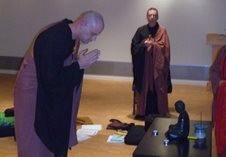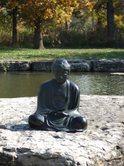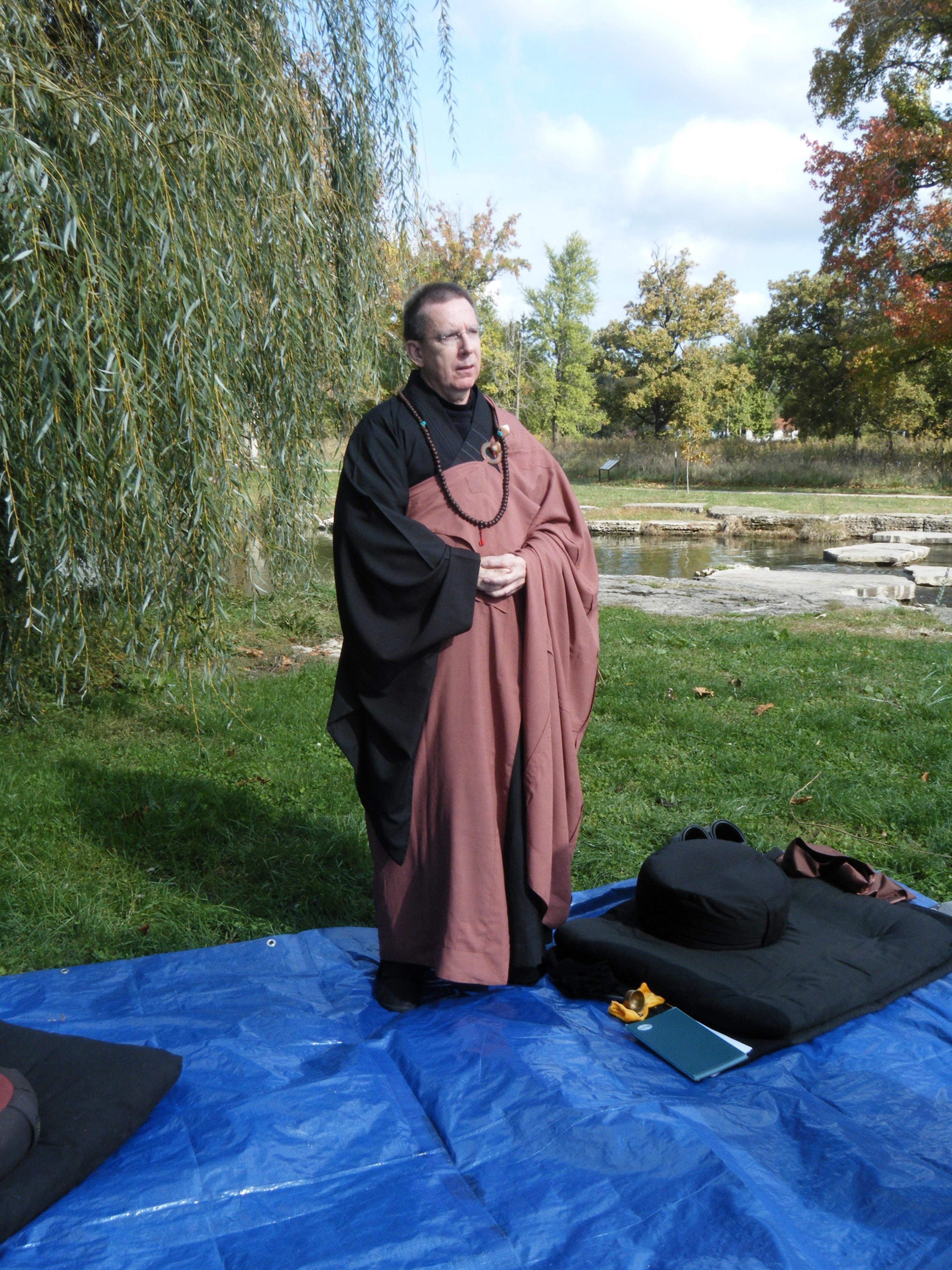By: David Xi-Ken Astor, Sensei
We should never underestimate the role any culture plays in the transformation of ideas, because the society we live in places heavy influences on how we interpret the world around us. This is true today as it was for the Buddha in his day. As you are aware, Siddhartha (the Buddha) was a practicing Hindu from a noble family clan. He was well educated. But he began to question the basic perceptions and realities universally held by the society he engaged during his life time. As a result he came to an awakened understanding of the causal nature of the Universe. He spent the remaindered of his life finding skillful language to describe this new worldview. Upon his death, and after many decades, these teachings became the foundation of Buddhism. But after his death, and without his guiding hand, other cultural influences began to creep into how Buddhist theory began to be interpreted. As expected, many conflicting views began to find their way into how the dharma was taught and as expected found their way into some of the Buddhist cannon we have today. This is why using caution is so important as we study ancient Buddhist writings and the suttas, as well as our legacy masters that themselves lived with the world views held during the middle ages.
Over the next few centuries Buddhism began to move East through Afghanistan, Tibet, China, Indochina, Korea, and Japan. As this migration happened, Buddhism encountered different social norms and adopted some of these indigenous cultural and religious beliefs into how they began to practice Buddhism. In Tibet it was B’on, in China it was Tao & Confucianism among others, and in Japan it was Shinto. But as Buddhism moved East it found similar ethical, moral and legal standards, and similar notions of freedom that was still specifically Asian. It was not until the early 40’s that Buddhism made it’s way to the West in earnest after World War II, although it found some roots in America before that in the 19th century, mostly from Chinese immigrants. As Buddhism encountered Western philosophy and science it crashed headlong into the most challenging transformation of its history. It encountered a different worldview philosophy that engendered a new way of considering individual freedom, as well as different foundations of law and social justice. Not to mention the challenge of transforming these Eastern ideas into Western languages.
As Buddhism encounters our contemporary world, especially as it moves West, it discovers situations where imagination and creativity are central to our notion of personal and social freedom. While Buddhist traditions have consistently affirmed freedom FROM craving, anguish, and unsatisfactoriness, being the path to awakening, they have been less consistent in affirming the freedom TO respond creatively to the suffering in the world as we see it today. Thus the emerging focus on engaged Buddhism over the past two decades has heated up. This is a reflection of the gradual influence that engaged Buddhism has received since Thich Nhat Hanh introduced the movement in the late 1960’s.
As Buddhism flourished in the East, various traditions inclined toward political and social conservatism. It was nourished in ancient cultures influenced by mysticism and the idea that we must focus on our own awakening, and the path to freedom, over that of others.
At the heart of Buddhism’s encounter with the contemporary world is the convergence of two visions of freedom. The Buddha’s freedom (as is defined in the Four Noble Truths) from craving and anguish, is converging with the West’s notion of individual freedom defined within the framework of social justice, and one’s own responsibility to realize our capacity for personal and social fulfillment.
It is on this principle of individual responsibility for one’s actions that the Buddha considered how freedom was to be enacted among his disciples and students. This was not the normal student/teacher relationship of his day. In the mahaparinibbana sutta, the Buddha says that he never thought of controlling the Sangha’s freedom of engagement, nor did he want the Sangha to depend on him. He said that there was no esoteric doctrine in his teaching, nothing hidden in the ‘closed-fist of the teacher’. I see this as the first call for us to find the freedom within our own practice to engage with others by using the tools of skillful means, not just blindly using what I call “the Buddha franchise”. This is the driving principle of Mahayana Buddhism. The freedom of thought allowed by the Buddha is unheard of elsewhere in the history of religions where strict adherence to established theological doctrine is demanded from the leadership, and imposed on their followers. Such freedom is necessary because, according to the Buddha, man’s emancipation depends on his own awareness and the ability to find ways to encounter the Dharma within dharma across time and cultures. (Big ‘D’ and little ‘d’ intended)
In today’s liberal democracies we are taught to realize the importance of our potential as autonomous persons. We are living in a world where many people experience a greater deal of freedom when compared with the past. But this is new to much of human history. Yet the exercise of these freedoms in the service of social greed and aggression has led to breakdown within community, destruction of the environment, wasteful exploitation of resources, and social injustices. In theory, freedom may be held in much high regard; in practice it is experienced as a surprising loss of meaning and direction for many. In many ways we are less free today than just a few decades ago, perhaps.
Part of the appeal of any belief system lies in its preserving a secure, structured, and purposeful vision of life. In offering such a refuge, traditional forms of Buddhism provide a solid basis for the ethical and philosophical values which is one of the driving forces that motivates us to step on the path to awareness. Yet, as the contemporary Buddhist teacher Stephen Batchelor says, “..they tend to be wary of participating in a translation of this liberating vision into a culture of awakening that addresses the specific anguish of the contemporary world.”
The Buddhist and contemporary visions of freedom both support and compliment each other. The Buddhist vision seeks to cultivate a path of individual and social practice that leads to a liberating experience of the notion of a “social-self.” The contemporary vision strives to create and maintain social and political structures that uphold the rights and optimize the creative possibilities of the individual. Buddhism should not accept the notion that freedom can be realized in a repressive and unjust society.
I do not think it is yet possible to describe the culture of awakening that could result from the encounter of these two visions, I do see, however, that two themes are beginning to emerge here in the West. These are the distinctively modern ways in which dharma practice is becoming less individually driven on the one hand, and socially engaged on the other. This is not true from what I can determine in the East. So this is one very important transformation Buddhism is going through as it begins to grow a sub-culture influence and cultural authority in the West. Language plays a dominate role in this emerging change.
I can not over emphases the importance of understanding the depth of the Four Noble Truths. On the surface they seem brief and simple to understand. But scratch the suffer of their meaning and you will find deep waters indeed. Especially if we come to awaken to the meaning “between” each of the Four Truths. The Buddha taught that we should set aside theories and metaphysical notions that have no useful and productive impact on our daily lives, that don’t lend themselves to finding ways to promote human flourishing. Having the freedom of viewing the dharma from a naturalistic and humanistic perspective for social engagement, we look at our own experiences after verifying their authenticity (what we pragmatically call experiential verification), which allows each of us no matter our worldview in finding creative ways to promote the greater good.
If training with a teacher of a certain school leads to a growing dependency on that tradition and a corresponding loss of personal values, then it might be necessary to seeks ways to reconcile the bond traditionally assumed in the student/teacher relationship as it is practiced in the West. At the same time, unprecedented exposure to a wide range of Buddhist traditions today makes it difficult to know when to accept a tradition’s unquestioned assumption of its own dominance. In valuing diversity and coming to realize the importance that the role pluralism plays in a contemporary practice, the modern Buddhist is challenged to find a balance between the traditional teachings of a specific lineage, and a need to discover a personal track of study that allows a flourishing practice within the dharma, even under guidance by a teacher.
The contemporary social engagement of dharma practice can no longer be rooted in just coming to realize our own unsatisfactoriness and attachments as just psychological drives, and useless personal preferences that effects our personal karma. But these human characteristics we work so hard to understand effect all aspects of the quality of life for us all. Such a socially engaged vision of dharma practice recognizes that each practitioner is obliged by an ethics of empathy to respond to the global suffering of our interdependent world.
Both individual and social engagement are not unique to the contemporary situation of today’s global challenges. Whenever a cultural awakening has been realized in the past, it has arisen through the original imaginative vision of an individual. In Buddhism it is Siddhartha Gotama. It has then been embodied in social structures as is driven by change. Modern democracy, science, and education have led to the role of the individual in society and the nature of social relations being radically different today from former times in Asia. The process between the individual and social engagement are needed for the realization of our contemporary culture to awaken to the lessons Buddhism embodies. It is not a given in a culture based on Christian/Judaic principals. Even if there are many similarities, which there are.
Buddhism is a biopsychosocial phenomenon designed to meet the needs of
individuals and their societies. It co-evolves with sociopolitical circumstances. When Buddhism takes on a new transformation, it retains the most useful elements of previous versions while absorbing the most useful elements of the new culture. We have the freedom and responsibility in the West to realize how creative re-description will allow us to cultivate an ideal approach to Buddhism for today’s modern world. An ideal Buddhism for today is built on a thorough understanding of the successes of our past. But it demands our understanding of the causal factors that also influence how change works and ideas flourish. This is why scholarship is so important for the Buddhist leadership. This change will make some Dharma Holders uncomfortable I’m sure. But we do not live in a static Universe. Even the Dali Lama said that for Buddhism to flourish and survive, it must successfully engage the West, and develop roots in the subsequent sub-culture it nourishes. We have to discern between what elements are vital for the survival of dharma practice and what are alien cultural artifacts that might obstruct that survival. What is to be cultivated, according to the Buddha, is a path of authentic vision, ideas, speech, action, resolve, mindfulness, and focused awareness. Hence a culture of awakening is a state in which this path is being cultivated.
It is my belief that a developing dharma practice is only as valuable as the social engagement that is brought into action with intent. We learn by doing. Study, meditation, and personal practice is not enough. You must put what you learn into action. Even for those monastic’s that have chosen a life of communal practice within a more structured environment. Only by social engagement do you encounter the lessons in “real-time”. We must get out and do, even if it is not under a Buddhist banner. Personal practice and social engagement can not exist apart from each other. Trust me when I say this. It comes from my own experience over years of fits and starts. At the same time, it is the creative tension between them that constantly forms and shapes our culture. Personal and social engagement become the two poles of a culture of awakening.
Our communities are the living link between individual and social engagement. How to create an authentic community-based-Sangha, which provides a sound basis for the emergence of a culture while optimizing individual freedom, may be the single most important question facing those practicing the dharma today. Maybe Stephen Batchelor said this best, “The democratic and agnostic imperatives of the secular world demand not another Buddhist Church, but an individuated community, where creative imagination and social engagement are valued as highly as philosophic reflection and meditative attainment.” As Buddhists we can work to provide a foundation for supporting this effort. In other words, use our Buddhist toolbox, and craft a compassionate world, one community at a time. We have the freedom, we only need now to discover the signposts the Buddha gave us along the path, when we take the time to see. Lay Sangha’s can work to achieve this, monastic communities can work to effect outreach, but the two working together will bring the balance that supports a new foundation for the future of Buddhism in a West more comfortable to change.


















































































